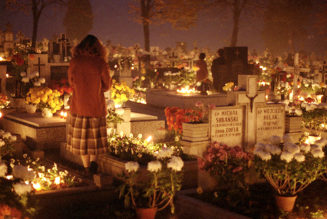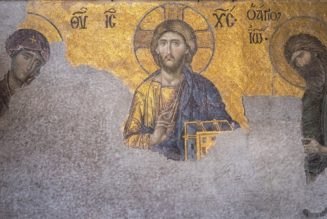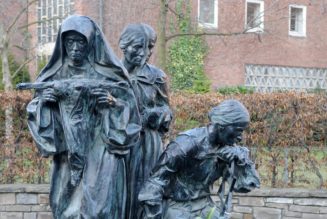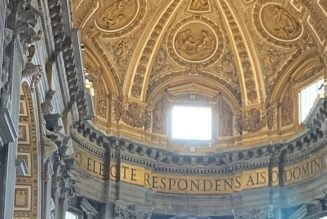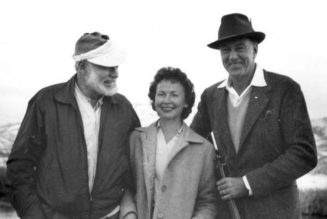
Hey everybody,
Today is the feast of All Dominican Saints, and you’re reading The Tuesday Pillar Post.
Among those Dominican saints is Fr. Hyacinth Castañeda, who — 250 years ago today, on Nov. 7, 1773 — was beheaded in a prison in Hanoi, Vietnam, where he had gone to preach the Gospel.
He was 30 years old.
Hyacinth was born to a comfortable and devout Catholic family in Spain; he entered the Dominican order when he was 14 years old, and professed his first vows days before his 16th birthday.
Two years later, men of Hyacinth’s province were asked to consider volunteering for missionary ministry in Southeast Asia.
Hyacinth put his name forward, and he was soon on a ship. Taking a long route — across the Atlantic, across Mexico, and then across the Pacific — the journey was tough. Hyacinth was sick for most of it, the ships were in disrepair, and he had to march across Mexico in ill health.
It took almost one year to arrive in Manila. When he got there, he ran into some trouble with a band of English privateers (pirates), and it took Hyacinth and his companions months to find other missionaries in the city.
But they persisted.
In 1765, when he was 22, Hyacinth was ordained a priest, on the Philippine island of Cebu. Four months later, he was sent to China — being snuck into the country after spending months holed up in Macau’s port, learning Chinese.
In China, Hyacinth faced the prospect of preaching an illegal Gospel, while trying not to bring harsh punishment to the Christians he was serving.
But in 1769, he was kidnapped, and a ransom was demanded of the small Christian community he served. When they couldn’t pay, Hyacinth was handed over to local civic leaders, tried in court, and exiled.
He was sent to Tonkin — modern day Vietnam — where Dominican missionaries had been present for almost 100 years, but where Christians were still persecuted by government leaders.
In Vietnam, Hyacinth tended to a Christian community — mostly offering the sacraments and catechizing. He kept night hours, to avoid running afoul of local authorities.
But after three years, Hyacinth was captured by pirates. A ransom was demanded of him; he couldn’t pay. Hyacinth was again turned over by kidnappers to local authorities.
That time, he wasn’t deported.
Instead, Hyacinth was imprisoned in a small outdoor cage, made an example of. He spent a summer in that cage, and then, in October, he had a cellmate — a fellow Dominican, Fr. Vinh Sơn Hòa Bình, a seminary professor in Vietnam.
They preached the Gospel from their cage. They were interrogated by authorities wanting to root out Christian communities in the region. They were beaten.
And then in early November, 1773, they were found guilty of proselytization. They were sentenced to die. And on November 7, 1773, Fr. Hyacinth and Fr. Vinh were beheaded. By some accounts, they died while praising the name of Jesus.
St. Hyacinth Castañeda, pray for us.
The news
You can read our report on that subject here.
A few hours after our reporting, a report emerged in The Remnant, a publication dedicated to “fighting against [the modernist] revolution in the Church,” which also reported possible changes to the general congregations. But in addition to the possible changes we mentioned, that report suggested that Pope Francis might be considering the addition of laity to the actual conclave voting for a new pope — an idea well beyond what The Pillar had heard.
In any case, that report generated a lot of discussion.
The Pillar, of course, stands by our original reporting.
But on Monday morning, Cardinal Ghirlanda issued a series of denials, telling some news outlets that the notion of changes to the papal election process were “absolutely false,” and that he did “not know anything about it.”
You can read more about those denials here.
And, please, make of this unfolding scenario what you will. We’ll continue to bring you the news, as we investigate and confirm, as always!
That’s what you count on us for.
—
The Pillar reported Friday that Bishop Karl-Heinz Wiesemann of Speyer, Germany, has asked priests to bless same-sex couples, in ceremonies which “explicitly reinforce the love, commitment, and mutual responsibility in the couple’s relationship as an act of blessing.”
The bishop has also campaigned for a “reassessment of homosexuality in Church teaching.”
While the Speyer decision contravenes explicit Vatican instruction on the matter of same-sex blessings, the Apostolic See has not yet responded to Bishop Wiesemann’s decision.
You can read that reporting here.
And here’s the update: sources confirmed that Bishop Li did not attend the Mass, and Zen did — though it is not clear whether Li wasn’t able to travel to the Mass, or whether he chose to stay at home.
In either case, the brouhaha points to the fractious state of affairs among the Chinese bishops — especially as Beijing continues to violate the terms of its agreement with the Vatican on the appointment of new bishops. In other words, this problem isn’t going away.
And Li is due in Hong Kong for a formal visit next week.
And you can read about it here.
This week’s Pillar Post is brought to you by Thomason Arts. We create original art and affordable limited edition reproductions for contemporary beauty to flourish in community and culture. As working artists we witness to the reality of the Holy Spirit inspiring people today. Use the code “beauty” at checkout and save 15%.
As many of you know, Pope Francis last week promulgated a motu proprio outlining his call for a “paradigm shift” in the way the Church does theology.
This motu proprio could have long-lasting and significant effects on the way the Church’s theologians do their work, and the way that bishops talk about that work. In short, this document is not without significant potential impact for the way pastoral ministry is done in a parish like yours.
—
Some of you might have noticed a little flare-up online this weekend, regarding a controversial tweet from Archbishop Gustavo Garcia-Siller — which, some people said, seemed to offer a controversial opinion on the legal regulation of abortion.
We checked with the Archdiocese of San Antonio, which said that the archbishop had been misunderstood, and that his pro-life bona fides are beyond reproach.
Does the explanation of the tweet make sense? You decide.
—
Arabian day: A Pillar adventure
Finally, here’s a story I am really excited to bring you.
When I was in Rome last month for the synod on synodality, I took a quick side trip to Dubai, in the United Arab Emirates, for the two purposes: I wanted to visit my expatriate sister and her family, and I wanted to visit St. Mary’s Parish — which is often said to be the most populous parish in the world.
I don’t know if St. Mary’s is actually the most populous parish — (over a few hundred thousand, who can be sure?) — but it was a beautiful community, and I’m glad I visited it, especially since Pope Francis will be headed to Dubai at the end of this month.
I hope you’ll read my report on the parish right here.
And I hope you’ll let me tell you a bit more about the trip.
First: I hope you’ll visit Dubai, if you get a chance.
It is one of the most fascinating places I have been. An absolute Islamist monarchy — an integralist “pre-liberal society,” if you will — which is also bent on becoming a global economic power, and a cosmopolitan world city.
Dubai is not just one thing — it is hundreds of shopping malls, alongside abandoned construction projects, alongside families eating ice cream at the beach, alongside scores of mosques, alongside the world’s most expensive hotels, alongside laborers working in highly-criticized conditions, all at once.
There is no sense in searching for the “authentic Dubai,” or the “real Dubai,” because Dubai’s reality is still coming into focus — before oil struck in the 1960s, it was a little pearl-diving outpost on the Persian Gulf coast.
There is tremendous energy, chaos, beauty, and suffering there, all at once. And the people of Dubai — more than 85% of whom come from somewhere else — are all there aiming to make a good living, and to carve out a better life for themselves and for their family.
I was struck most especially by the hospitality of the place. I walked around a few neighborhoods — some of which were middle class Western expat neighborhoods, and some of which were the urban, poor neighborhoods of laborers, and I was struck in both cases by how often someone offered a glass of water, or asked if I needed anything. Not in a pushy, salesguy kind of way, but in a way that suggested that hospitality is both a residual and emerging part of Dubai’s culture.
People in Dubai also seem to like selfies a lot.
For example, there was the owner of this grocery shop:
He was pretty insistent that I take a selfie with this Santa he’s got in the store, which he seemed to pride himself on. Like, very insistent. So who am I to say no?
As to hospitality, there was also the steward at the parish, who asked me several times if I needed to use the lavatory, and then showed me to this place — the most elaborate outdoor lavatory I’ve had the privilege of using:
There was also the street vendor who gave me, as a free sample, this — a pastry containing a well-spiced hard boiled egg:
He probably knew I’d buy several more, which I did.
Now — I do not hope you will try to visit Dubai as a day trip from Rome, like I did.
Or, if you do, I hope you will not do so using Egypt Air, which I now can confirm is the world’s worst airline.
On that airline, I took a late night flight from Rome to Cairo — a flight of three hours and change — during which the lights were kept bright the entire time, and a dinner was served at approximately midnight.
Then, after a layover, I took an overnight flight to Dubai, during which the lights were kept bright the entire time, and a dinner was served at approximately 2:30 a.m.
I did not manage to sleep. I did manage to see “About My Father,” the worst movie Robert De Niro ever made.
And in the Cairo airport, in the middle of the night, I got into a bit of a tussle with a cop at a security checkpoint, who tried to walk away from me with my passport. I never let someone walk away with my passport. So I’m not too popular with the Cairo PD.
On the way back, again through Cairo, I had some time to kill, and considered making a trip into the city of Cairo itself.
Cairo’s airport — much of it outdoors — has a distinctly developing-world urban smell of illicit copper smelting, coupled with lots of kerosene cooking. That unique smell, in my experience, signifies a city unlike either Dubai or Denver, where I live, and worth exploring.
But ultimately, I wasn’t confident I’d get back in time. If I missed my flight, I’d have missed a synod on synodality press conference. Duty called, I guess.
Still, I’d like to go back and do some reporting for you there.
In the meantime, if you’re going to Dubai, give yourself at least 48 hours for the trip. Trying to do it in 36 hours, start to finish, was a lot — at least for a guy on my side of 40.
But I did get to go night-swimming in the Persian Gulf, so I’d call it a pretty good adventure on the whole.
Thanks, Pillar subscribers, for letting me report on the life of the Church for you, from all corners of the globe.
We’re a subscriber-funded operation, so if you want to see me go more places, you know what to do:
Please be assured of our prayers, and please pray for us. We need it.
Yours in Christ,
JD Flynn
editor-in-chief
The Pillar.
PS: I had a pretty great dinner with my sister’s family, including my godson Ethan, in the front left:
This week’s Pillar Post is brought to you by Thomason Arts. We create original art and affordable limited edition reproductions for contemporary beauty to flourish in community and culture. As working artists we witness to the reality of the Holy Spirit inspiring people today. Use the code “beauty” at checkout and save 15%.
Comments 20
Services Marketplace – Listings, Bookings & Reviews


